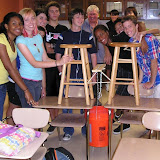It starts, obviously, with being the best student that you can be. Now, that doesn’t always mean that you have to have a perfect score on every assignment. It doesn’t mean that you’ve got to get straight As all the time -- although that’s not a bad goal to have. It means that you have to stay at it. You have to be determined and you have to persevere. It means you’ve got to work as hard as you know how to work. And it means that you’ve got to take some risks once in a while. You can’t avoid the class that you think might be hard because you’re worried about getting the best grade if that’s a subject that you think you need to prepare you for your future. You’ve got to wonder. You’ve got to question. You’ve got to explore. And every once in a while, you need to color outside of the lines.
It starts, obviously, with being the best student that you can be. Now, that doesn’t always mean that you have to have a perfect score on every assignment. It doesn’t mean that you’ve got to get straight As all the time -- although that’s not a bad goal to have. It means that you have to stay at it. You have to be determined and you have to persevere. It means you’ve got to work as hard as you know how to work. And it means that you’ve got to take some risks once in a while. You can’t avoid the class that you think might be hard because you’re worried about getting the best grade if that’s a subject that you think you need to prepare you for your future. You’ve got to wonder. You’ve got to question. You’ve got to explore. And every once in a while, you need to color outside of the lines.
That’s what school is for: discovering new passions, acquiring new skills, making use of this incredible time that you have to prepare yourself and give yourself the skills that you’re going to need to pursue the kind of careers that you want. And that’s why when you’re still a student you can explore a wide range of possibilities. One hour you can be an artist; the next, an author; the next, a scientist, or a historian, or a carpenter. This is the time where you can try out new interests and test new ideas. And the more you do, the sooner you’ll figure out what makes you come alive, what stirs you, what makes you excited -- the career that you want to pursue.
The President explained that being engaged in school is not just for the students themselves, but for the country as a whole. He acknowledged that young people today are growing up fast and students have a lot of responsibility to take on, "because you’re not just kids. You’re this country’s future. You’re young leaders. And whether we fall behind or race ahead as a nation is going to depend in large part on you."


 http://mashable.com/2011/09/07/stem-microsoft-infographic/
http://mashable.com/2011/09/07/stem-microsoft-infographic/


 The twin Gravity Recovery and Interior Laboratory, or GRAIL, spacecraft will fly in tandem orbits around the moon for several months to provide in-depth data for scientists to analyze in order to better understand the moon's gravitational characteristics, structure, thermal evolution and history of collisions with asteroids. There are two instantaneous (one-second) launch windows open at 8:37 a.m. and 9:16 a.m. Eastern time on Thursday, Sept. 8. The launch period extends through Oct. 19.
The twin Gravity Recovery and Interior Laboratory, or GRAIL, spacecraft will fly in tandem orbits around the moon for several months to provide in-depth data for scientists to analyze in order to better understand the moon's gravitational characteristics, structure, thermal evolution and history of collisions with asteroids. There are two instantaneous (one-second) launch windows open at 8:37 a.m. and 9:16 a.m. Eastern time on Thursday, Sept. 8. The launch period extends through Oct. 19.

